December 2019 – Region 9 Reports
REGION 9 REPORTS – DECEMBER 2019 NEWSLETTER
ASCE Region 9 Accomplishments Over the Past Year
Kwame A. Agyare, P.E., ENV SP, M. ASCE
ASCE Region 9 Director, and
Chair, ASCE Region 9 Board of Governors

September 30th marks the end of the Region 9 fiscal year, and during last month’s Board face-to face meeting, the Board of Governors, among other actions, performed a review of the accomplishments of this past year and prepared plans for future years.
The Region Governors identified the major accomplishments of Region 9 and its organizational entities toward implementing the Society’s six Strategic Goals involving Membership, Innovation, Sustainable Infrastructure, Education and Professional Standards, Public Value, and Strategic and Operational Effectiveness:
- The Region through various events and activities throughout the year, as shown in the below Region 9 Infographic, continued to communicate the enhanced ASCE member values toward the goal of increasing membership recruitment and retention. Development of an updated strategic plan is underway to continue to engage and recruit members to ASCE;
- Undoubtedly one of the most significant achievements of the Region 9 Board and its committees this year was the completion of the 2019 Report Card for California Infrastructure, a feat that was accomplished under the guidance of the co-Chairs, Tony Akel and John Hogan, and by the work of several dozen Region 9 volunteers with the assistance of ASCE Government Relations & Infrastructure Committee staff, as well as the ASCE Committee for America’s Infrastructure. 17 categories of infrastructure in the State were ranked and given a report card grade. These grades which are attached will inform the public about the condition of the State’s infrastructure and will serve as a basis for Region 9’s advocacy efforts in infrastructure in the upcoming years. My sincere gratitude goes out to all who volunteered for this significant update to the previous 2012 report card;
- The Region continues to promote sustainable infrastructure through the activities of the Region 9 Sustainability Committee, chaired by Mark Norton, and through encouragement and promoting of local ASCE sustainability committees operating in each of the four Sections (San Diego, San Francisco, Sacramento, and Los Angeles). This year, the Committee organized an Envision® Training Workshop the day prior to the Region 9 Infrastructure Symposium held in San Diego in March. About 16 professionals were trained to become Envision® Sustainability Professionals at the workshop. The Region also sought to provide volunteers and encourage support for the International Conference on Sustainable Infrastructure held in Los Angeles in November 2019 and chaired by Mark Norton;
- Region 9 Legislative Day Fly-In to Sacramento and Legislation Support – This year’s Legislative Day Fly-In event was held in conjunction with the release of the new 2019 California Report Card, at an event held on the lawn at the Sacramento State Capitol, and attended by legislators, ASCE members, and engineering professionals. The event was well attended. Region 9 continues with its goal to introduce an increasing number of engineers to the legislative process and advocacy, held a pre-event webinar and held a morning training session to orient members who are new to the legislative process and the work being done by our Region 9 infrastructure advocacy initiative, and to also illustrate how they can effectively participate in the advocacy process. The second half of the day was spent visiting State Legislators to discuss pending legislation related to infrastructure, and to distribute copies of the new report card to almost all State legislative offices. ASCE Region 9 attendees also offered to provide their technical expertise related to future bills and issues impacting the civil engineering profession, to these legislators. This activity is held each year in the spring, and Region 9 members are encouraged to participate. The Region 9 committees of Transportation, Water, and Government Relations regularly reviewed legislation, which resulted in a significant number of “support” letters to California State Legislators and the Governor;
- California Infrastructure Symposium – Another significant annual activity is the annual Region 9 Infrastructure Symposium. This year, Region 9 partnered with the San Diego Section to host this event. The day-long Infrastructure Symposium addressed the major issues in transportation and water. Region 9 greatly appreciates all of the efforts of the San Diego Section members that worked so hard to make this event a success.
There were a number of other accomplishments throughout the year. Below are just some of the many other achievements of the Region 9 Governors, Committee Chairs, Sections, Branches, and Younger Member Groups:
- Region 9 Envision Training Workshop – Another successful workshop was held in conjunction with the Region 9 Infrastructure Symposium, and 16 professionals participated in the event;
- Region 9 Younger Member Committee – This committee continued its operations with representation from all four Sections on the committee;
- Disaster Preparedness Training – Region 9 Disaster Preparedness Committee Chair, Doug Taylor, focused on stepping up the efforts to train members to receive California Safety Assessment Program (SAP) certification, and held several informational sessions throughout California during the year;
- California PE Board (BPELSG) Committee Meetings – Region 9 was able to provide ASCE representation at many BPELSG meetings throughout the year. The Region also supported legislation for the renewal of the BPELSG for a further four years;
- Region 9 Awards Recognition – Region 9 held another successful Region Awards Dinner event at the San Diego Convention Center;
- Legislative Advocacy – Region 9 Committees reviewed throughout the year many State Assembly or Senate bills affecting the civil engineering profession and the Board of Governors approved more than a dozen “support” or “oppose” letters, which were sent to State legislators;
- Ballot Initiative Opposition – The Region 9 Board of Governors participated along with several hundred agencies, engineering societies and groups, to oppose the No on Prop 6 initiative on the November 2018 ballot. This was a highly successful advocacy effort and thanks are given to all those that assisted in this effort;
- Governors Serve on Society Committees – Part of the responsibility of a Region 9 Governor is to seek to serve on a Society Committee. Several current Region 9 Governors sit on Society committees, including the Member Communities Committee (Kwame Agyare – Member); Committee on Student Activities (Matt Kennedy – Member); Public Agency Peer Review Committee (Kwame Agyare – Corresponding Member); Public Policy Committee (Ken Rosenfield – Member) and Committee on Preparing the Future Civil Engineer (Ken Rosenfield – Member, Kwame Agyare- Corresponding Member). If you have a concern or question about your Society you may contact your Region Governor, and they can steer your inquiry so that it can be addressed by the proper committee and, if necessary, brought to the attention of the Society’s Board of Direction;
- OCEA Awards – A project from the San Francisco Area, the Salesforce Tower was selected to receive an Honor Award, and possibly the 2020 Outstanding Civil Engineering Achievement (OCEA) Award, to be chosen in March 2020 at the ASCE Awards Ceremony;
- OCEA Awards – A project from the Sacramento Area, the Spillways Oroville Emergency Recovery project was selected to receive an Honor Award, and possibly the 2020 Outstanding Civil Engineering Achievement (OCEA) Award, to be chosen in March 2020 at the ASCE Awards Ceremony;
- Emmanuel CB (Cris) Liban, P.E., D.Env, ENV SP, F.ASCE, of the Los Angeles Section was selected for the 2019 Government Civil Engineer of the Year Award for “his leadership and engineering contributions in public service at LA Metro and his work incorporating sustainability in engineering.”;
- Costas E. Synolakis, Ph.D. of the Los Angeles Section was selected by ASCE’s Coasts, Oceans, Ports and Rivers Institute to receive the 2019 International Coastal Engineering Award for “his three-decade-long pioneering efforts in the field of tsunami research that has not only transformed scientists’ understanding of tsunamis but also saved countless lives.”;
- The Los Angeles Younger Member Forum was been selected by the Committee on Younger Members to receive the 2019 Younger Member Group Award for large groups for “outstanding professional, technical, social, outreach, and community service activities on behalf of the Los Angeles Section.”;
- James L. Beck, Ph.D., F.EMI, M.ASCE of the Los Angeles Section was selected by the Engineering Mechanics Institute to receive the 2019 Masanobu Shinozuka Medal for “original contributions to subset simulation in reliability analysis of stochastic systems, a powerful technique that allows probabilistic estimation of rare events, and your pioneering work in developing technologies for machine learning in earthquake engineering applications.”;
- Monica Morales, P.E., ENV SP, M.ASCE of the Los Angeles Section was selected by the Committee on Younger Members to receive the 2019 Daniel W. Mead Prize for Younger Members for the paper, “Inclusion and Diversity: Engineering Ethics.”;
- The Los Angeles ASCE Student Chapter was been awarded the 2019 ASCE Distinguished Chapter Award for Region 9 by the ASCE Committee on Student Members. This award is made annually “to the most outstanding Student Organization in the Region.”;
- Derek Slovenec, S.M.ASCE, Bing Qu, Ph.D., P.E., M.ASCE, and Gilberto Mosqueda, Ph.D., A.M.ASCE from ASCE Region 9 were selected by the Structural Engineering Institute to receive the 2019 Moisseiff Award for the paper, “Seismic Rehabilitation of Concentrically Braced Frames Using Stiff Rocking Cores,” published in the September 2017 issue of Journal of Structural Engineering;
- Shaily Mahendra, Ph.D., A.M.ASCE of the Los Angeles Section was selected by the Committee on Technical Advancement to receive the 2019 Walter L. Huber Civil Engineering Research Prize for “pioneering the application of enzyme-nanoparticle vaults in water treatment, significantly contributing to application of molecular biological and stable isotopic diagnostic tools in bioremediation of organic contaminants and advancing our understanding of the impact of nanomaterials on microbial ecosystems.”;
- Graham E.C. Bell, Ph.D., P.E., F.NACE, F.ASCE of the Los Angeles Section was selected by the Utility Engineering and Surveying Institute to receive the 2019 Stephen D. Bechtel Pipeline Engineering Award for an “exemplary 35-year career as a researcher, practitioner and educator, fostering a dynamic evolution of the industry for standard of care issues for the condition assessment, rehabilitation, and corrosion control for linear and vertical civil infrastructure.”;
- John T. Harvey, Ph.D., P.E., M.ASCE of the Sacramento Section was selected by the Transportation and Development Institute to receive the 2019 Frank M. Masters Transportation Engineering Award for “research, development and implementation results in the areas of pavement design, materials, rapid construction, pavement management and the quantification of environmental impacts on pavement that are used around the world.”;
- David S. Yang, Ph.D., P.E., G.E., M.ASCE of the San Francisco Section was selected by the Geo-Institute to receive the 2019 Martin S. Kapp Foundation Engineering Award for his “contributions to Deep Soil Mixing including the beneficial expansion of its use for containment and reinforcement applications. You have truly advanced the practice and been instrumental in overcoming the obstacles needed to bring this technology to North America.”;
- Farhang Ostadan, P.E., F.ASCE of the San Francisco Section was selected by the Energy Division to receive the 2019 Stephen D. Bechtel Jr. Energy Award for “significant contributions to practice, research and codification activities for advancing soil-structure-interaction analysis and seismic analysis in the energy industry, in particular the nuclear power industry.”;
- Jonathan D. Bray, Ph.D., P.E., NAE, F.ASCE of the San Francisco Section was selected by the Geo-Institute to receive the 2019 Karl Terzaghi Award for “effective leadership and contributions to the geotechnical engineering profession and for following in the footsteps of Karl Terzaghi in expanding the state of the art of the geo profession.”;
- The New United States Courthouse is one of five finalists for the 2019 Outstanding Civil Engineering Achievement (OCEA) award. The other finalists are: 150 North Riverside, Chicago, IL; OARS – OSIS Augmentation & Relief Sewer, Columbus, OH; Olympia Odos Motorway – EKPPT, Greece; SR 99 Alaskan Way Viaduct Replacement South Access – Northbound Off Ramp, Seattle, WA;
- Bill Dutra, A.M.ASCE of the San Francisco Section was selected by the Coasts, Oceans, Ports and Rivers Institute to receive the 2018 John G. Moffatt-Frank E. Nichol Harbor and Coastal Engineering Award “For his outstanding contributions in the construction of harbor and coastal projects bringing outstanding leadership, creativity and innovation enabling significant environmental and technological gains to the profession and society.”
These accomplishments could not have happened without the leadership and dedication of Governors, Section Presidents, Committee Chairs, and active members who give so much of their time to support ASCE and Region 9 activities. To them I would like to express my sincere appreciation and look forward to working with our members over the next year to continue to provide quality activities throughout the Region.
I would also like to take this time to thank Matt Kennedy and Thor Larsen, the two outgoing Governors, for their service over the past three years. Matt also served as the External Secretary and Awards Chair for the Region 9 Board. Thor served as Treasurer and Chair of the California PE Board (BPELSG) Committee. I would also like to say congratulations once more to the two newly elected Region Governors Rune Storesund and Elias Karam.
If you have any questions about Region 9 or your Society, please feel free to contact me at agyare.kwame@gmail.com
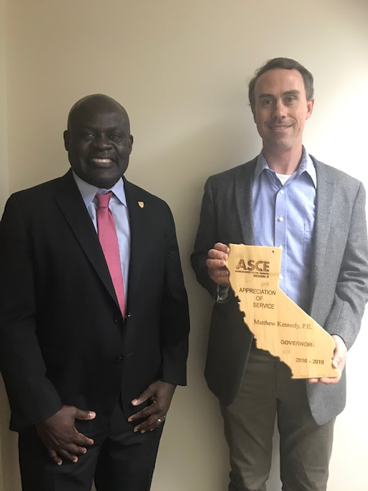 Kwame Agyare presents a plaque to Matt Kennedy in appreciation for his service as Region 9 Governor Kwame Agyare presents a plaque to Matt Kennedy in appreciation for his service as Region 9 Governor |
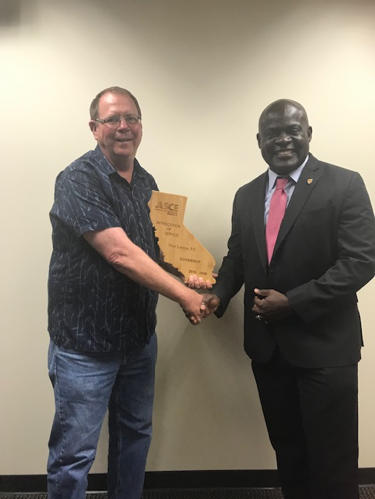 Kwame Agyare presents a plaque to Thor Larsen in appreciation for his service as Region 9 Governor Kwame Agyare presents a plaque to Thor Larsen in appreciation for his service as Region 9 Governor |
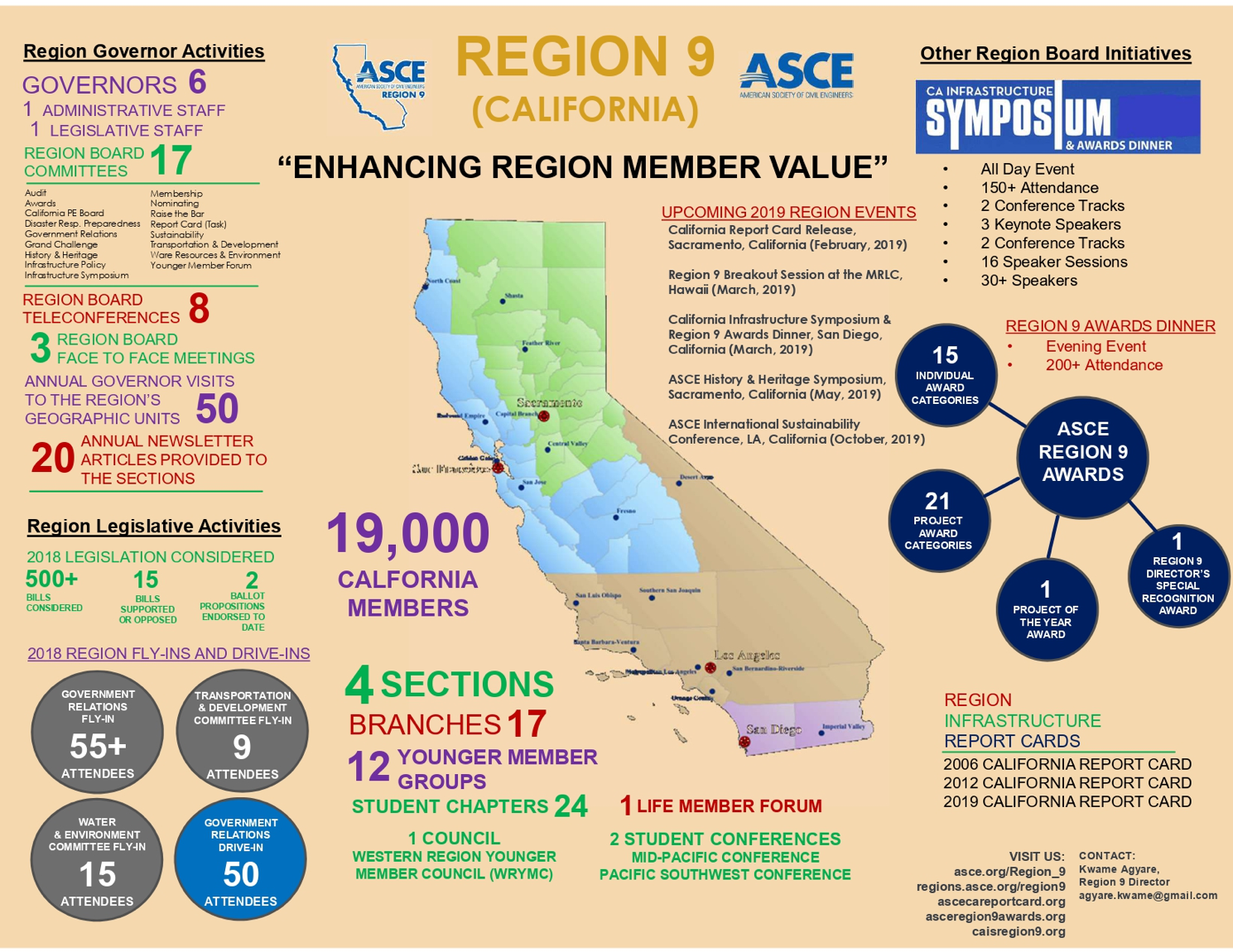
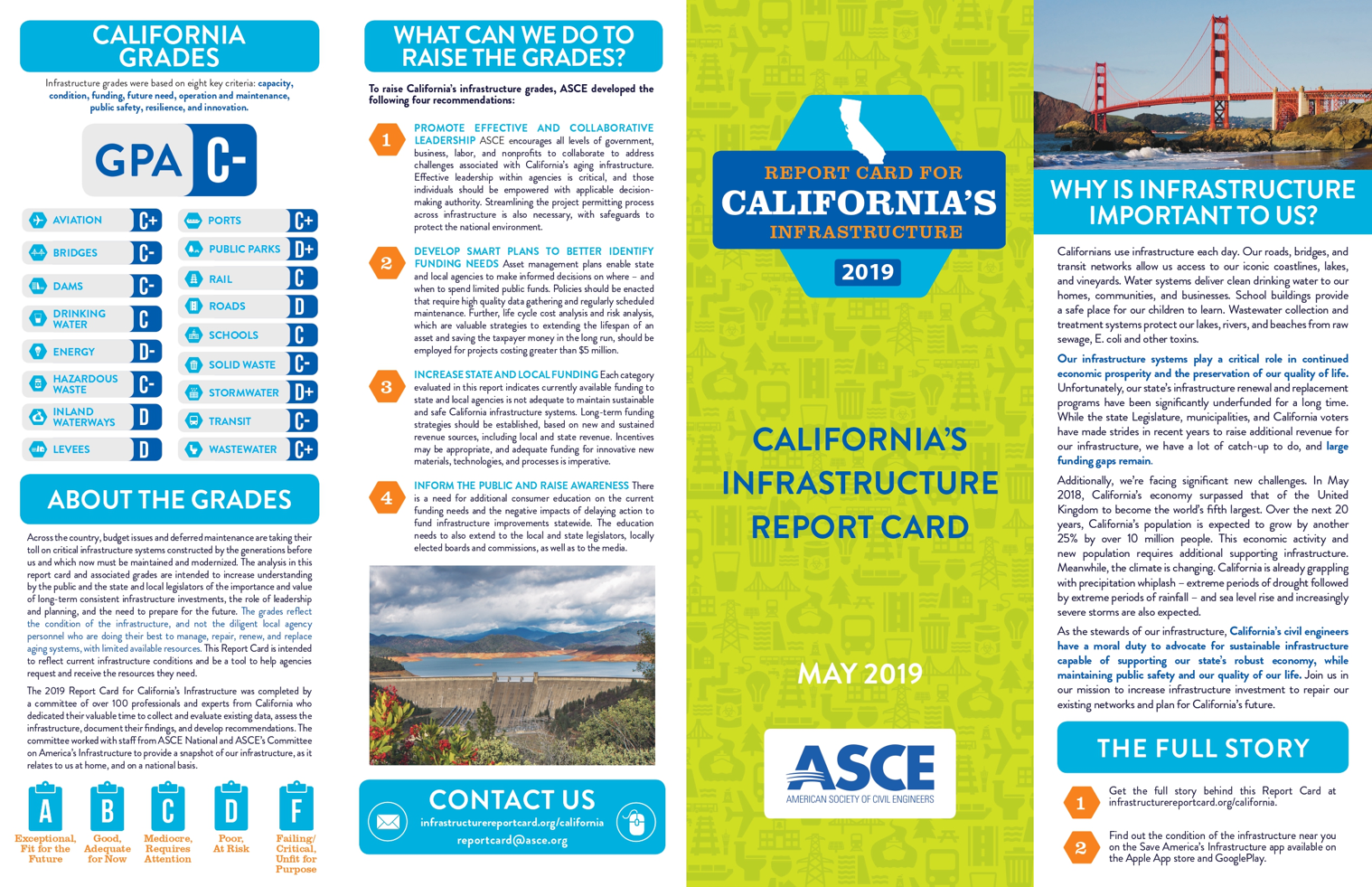

Navigating the North – ASCE Shasta Branch Update
by The ASCE Sacramento Section
Background of Shasta Branch
The ASCE Shasta Branch (the “Branch”) was established on September 11, 1951. The boundaries for the Shasta Branch include Lassen, Modoc, Shasta, Siskiyou, Tehama, and Trinity Counties in the northern tip of ASCE Region 9 (the State of California). The 113 ASCE member body consists of 1 fellow, 86 members, 18 associate members, 6 student members, and 2 affiliate members as of December 2018. 66 out of 105 members are Section Subscribing Members and 22 out of 113 are life members. The average number of years (Section Subscribing members) with ASCE is 24 years. Member backgrounds range from students to executives in both the private and public sectors. From historical perspective, the membership remained steady from the 1980s to 2007. New members joining ASCE in recent years generally do not pay Section dues.
Current Officers include President, Past President and Treasurer. The 2008 recession made an impact on the local economy and job market as well as the Branch. The Branch lost much of its membership with local engineers moving out of the profession or areas and fewer engineers became interested in carrying on organizing events and activities. Similar trends occurred in local organizations such as American Public Work Association (APWA), Society of Women Engineers (SWE) and even the Rotary Clubs. Other NGOs also took away many members. Another critical factor was the change of leadership at Shasta College. Being the one and only college that offered pre-engineering program locally, the strong Engineering program shrank substantially when a past president left. Lack of young members diminished a healthy growth of the Branch. Despite these facts, the current President, Ms. Susan Goodwin, held her office faithfully over the period, with assistance from the Treasurer, Mr. Will Bond, who kept the treasury records updated since 2012.
Germination
ASCE Sacramento Section President, Mike Konieczki connected the Branch to a very active Region 9 Membership Committee Chair: Elias Karam in November 2018 who provided the Branch officers with a member roster. Past Sacramento Section President, Adam Killinger, also chipped in with strong support and linkage to other branches. Mr. Radley Ott, the President of Feather River Branch at the time also provided input on his personal experience re-energizing his branch several years ago. An advisory Board of five, including Shasta College Dean, California State retirees, and City Officials in addition offered insight, speakers, and directions. The Sacramento Section monthly meeting kept bringing in ideas, potential contacts to interest members, the financial support for Branch nominees on participating in the MRLC conference, and a strong voice of encouragement. A kick-off meeting was scheduled on February 18th, 2019, where Sacramento Section Board and Region 9 members planned to visit the Branch. The main goal for the meeting was to share with the Branch how some of the other Branches operate, and to answer any questions. Due to schedule conflicts, the meeting was re-scheduled to April 4, 2019. To prepare for the face-to-face meeting with the Section, Branch officers gathered in a meeting at Caltrans District 2 Office on March 5th, 2019. The Branch President and Treasurer met with John Martin (Caltrans), Michael Randall (Jacobs), and Edward Wang (Reclamation) to form the initial task force. Their first action was to formalize the Branch Bylaws. All had many good ideas for programs and saw many opportunities to engage their colleagues to join. A strategic plan was proposed, prioritizing objectives and goals to re-engage members under targeted time and limited resources.
Planning Activities
A Member Survey from March 29th to April 15th, 2019 was conducted for the basis of activity planning. The 8-question anonymous questionnaire asked 113 local members about their background, preferences and ways of participating the local activities. It was not surprising to receive just 10 responses, and many emails bounced back showing a need for additional outreach and updating of the membership roster. The partial results are shown in Figure 1. To increase the success rate and foster a strong local program, organizers also participated in many local activities, meetings, and site visits sponsored by APWA, Rotary Club, ICC Shasta Cascade Chapter, California Board of Contractors…etc. to learn from their experience during planning stage.
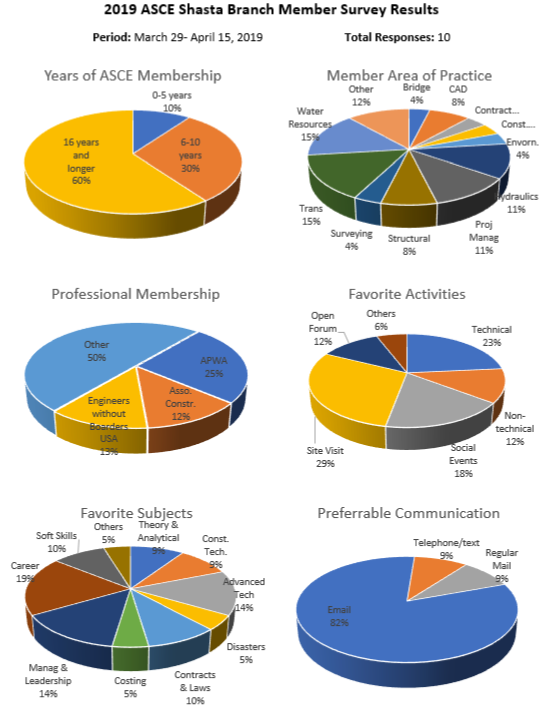
Figure 1. The Outcome of Membership Survey
The other challenge was to find a meeting place which was accessible to most members but free of charge. Five different seminars were proposed to be organized from April to August 2019, aiming at what works the best. The meeting venue, subject, number of speakers, target audience varies as well as the meeting day and time were chosen to optimize attendance. Sign-in sheets with signatures and contact information enlarged email list. A post-assessment survey from attendees was collected and reviewed at each following month’s officer meeting. The feedback received was all positive and encouraging. A list of activities, time, place, and subject are tabulated in Table 1. In general, the number of attendees increase with technical intensity and speaker background. Lunch hour seminars were preferable as a meeting time, rather than evenings. Seminar locations and means of promotion are key factors to the success of meetings. Online registration and issuing Certificate of Attendance do not effectively motivate people to come, as was noted.
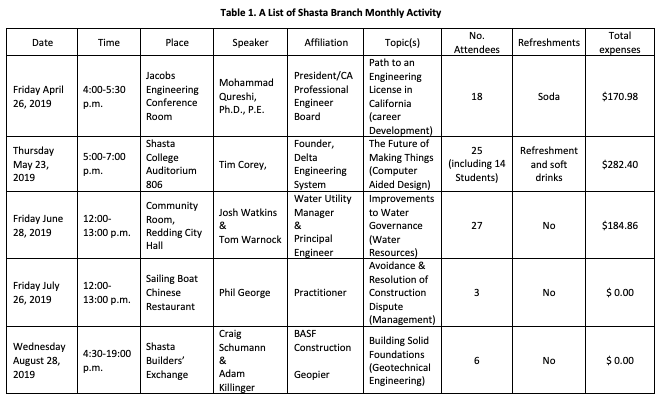
Note: Promotions included but not limited to: Email invitations, poster, flyers sent via regular mail, Letters from the President or the Dean, Social Media, and New Releases except Branch Website.
Lessons learned include that fact that attendance typically drops as soon as summertime arrives. It was also found later that other organizations skip meeting in July through September as well. Promotional flyers by regular mail reached a much broader audience than simply emailing to members. Social media may be considered for future promotions as well. Many thanks go out to Escott Anderson, the administrator of the ASCE Sacramento Section, who updated Branch website page in late July. This website now shows links to the Branch Facebook page and LinkedIn Group page. A majority of seminar attendees were non-ASCE members, which implies there is a great membership recruiting potential in the local engineering community. Current Branch members are scattered at 15-20 small firms, contractors (with 2-15 employees) and self-employment entities. Participants from major employers such as CH2M HILL (now Jacobs), PACE Engineering, City, County Government, and Caltrans are critical to future growth.
Looking Ahead
ASCE Shasta Branch currently has a strong foundation especially with its financial stronghold. The potential growth of the Branch relies on recruiting new members as well as retainage of existing members. Local consulting firms and contractors are an important part of the membership demographics. It will take a team effort and a strong leadership to build a successful Branch. The ASCE Membership Resources Website provided many useful information and templates towards this success, and the number of Branch officers grew from 5 to 7 in last few months. Adding the past President, Dale Roper, and a recent Chico State graduate, Dylan De Leon, who was the Chico Student Chapter President, will definitely boost the membership in the near future. Dylan is now settled in Redding and is bridging the Branch to Chico State. The Branch will be electing the 2019-2020 officers in the next few weeks. With active participation from leaders and officers, the 2020 Shasta Branch program will make a positive impact to the local community.
The Branch has a unique goal and purpose to differentiate us from other existing organizations. For instance, geographically scattered members pose a communication and participation challenge. The Branch will seek a way to conduct teleconferencing meetings and utilize other online communication resources. Officers organized several events between April to August, and this provided an accurate assessment of the budget and program via quantitative and qualitative evaluation. Connecting to neighboring Branches and the Sacramento Section, and bringing in young members, will help progressing to a sustainable development. The Shasta Branch also just announced the 2019 Student Scholarship for a second time, hoping to encourage additional younger member participation. On October 3rd, 2019, several Branch Officers visited Chico State for a meeting with the Student Chapter. Many thanks to Feather Branch President, Paul Peck, who agreed to possibly develop a joint program. Professor and Chair of Chico State, Dr. Steffen Mehl, also accepted an invitation to come to Redding in the Spring of 2020. This article documents the recent development and progress made for ASCE Shasta Branch. By sharing the recent development and lessons learned, the Branch is looking forward to receiving feedback and seeking advice from the Region, Section and Branch leaders.
Please contact Sacramento Section immediate Past President Michael Konieczki, Michael.Konieczki@hdrinc.com, if you need any additional information.

BuildStrong Coalition Disaster Mitigation and Resilience Forum Series – California Forum Overview
ASCE is a member of the BuildStrong Coalition. Key policymakers including officials from the Federal Emergency Management Agency (FEMA), state and local emergency managers and disaster officials from throughout the region, and leading stakeholders from the insurance and infrastructure industries will convene for the second forum in the Disaster Mitigation and Resilience Forum Series. This forum will focus on the risks and hazards related to wildfires and other disasters and how to mitigate those hazards.
ASCE members are encouraged to register and attend this important and informative event on Wednesday, November 13, 2019, in Sacramento, California
Register here for the forum https://forums.buildstrongamerica.com/#wildfire-and-earthquake
